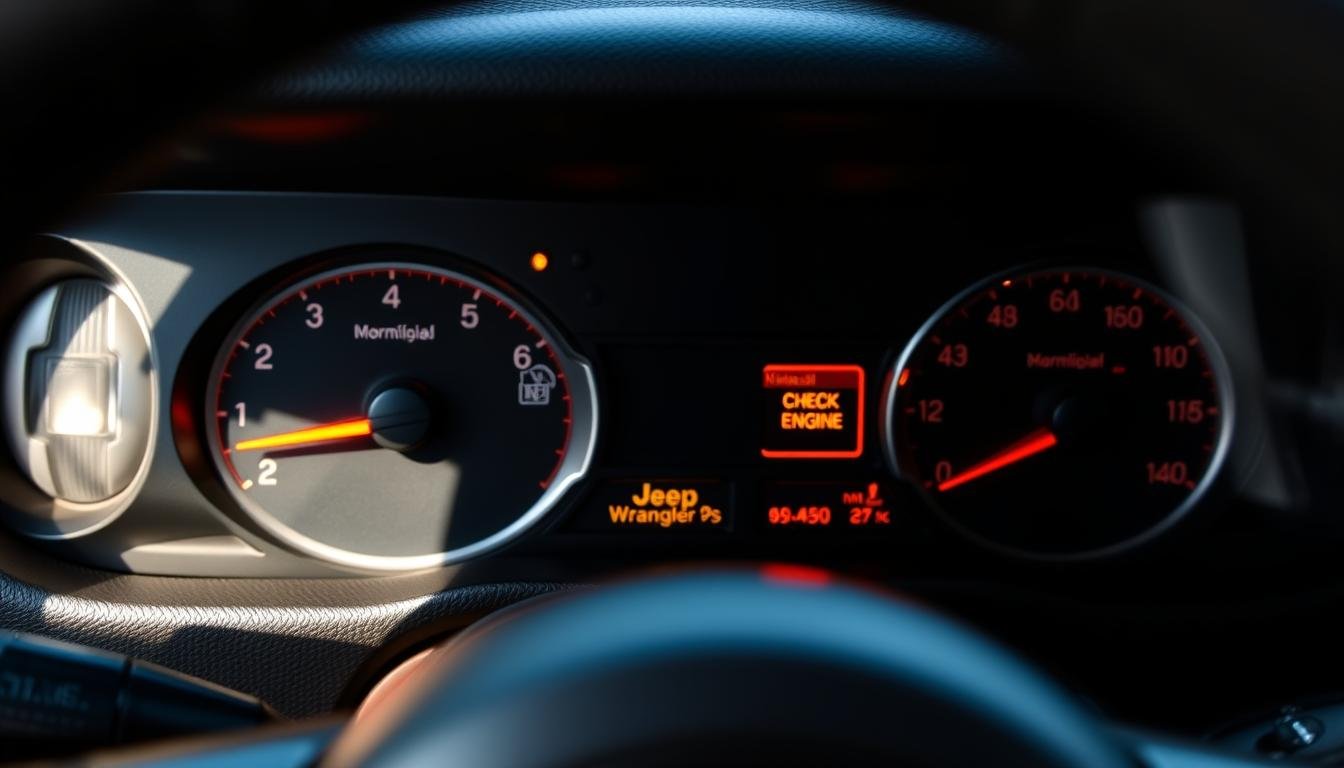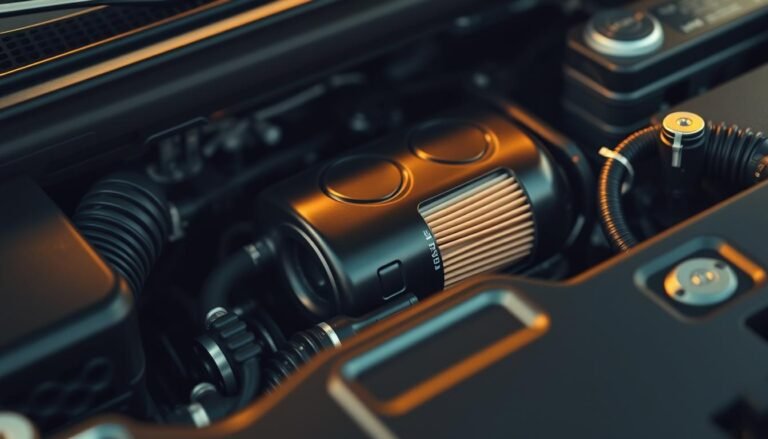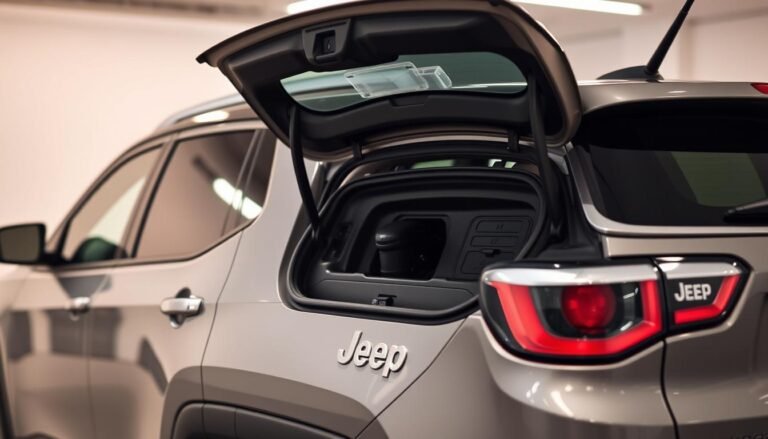How To Check Engine Light On Jeep Wrangler? Causes & Fixes
The check engine light on your Jeep Wrangler is important. It tells you about problems in your vehicle’s engine or systems.
When it lights up, it means you need to check things fast to avoid more trouble. Knowing about the Jeep Wrangler check engine light is key to keeping your car running well.
We’ll show you how to figure out and fix the check engine light issue. We’ll go over common problems, reading diagnostic codes, and how to reset the light.
By knowing these steps, you can handle the check engine light yourself. This saves both time and money on repairs. We promise to make it easy for you. Let’s get started!
What’s The Check Engine Light?
The check engine light on Jeep Wrangler is a key part of the vehicle’s diagnostic system. It warns when there’s a problem with the engine or emission controls.
You might see a yellow light, a “Check Engine” message, or a graphic of an engine. It’s important to know what the Jeep check engine light means.
If you ignore it, repairs could get expensive. Get it checked right away when it comes on. This light means the car needs to be checked to find what’s wrong.
Knowing why the check engine light comes on can help fix issues. A steady light usually means a small problem.
A blinking light warns of something more serious, like engine misfires. Taking action early keeps your Jeep Wrangler running well and avoids big problems.
Common Causes For Check Engine Light on Jeep Wrangler
It’s key to know why the check engine light might turn on in a Jeep Wrangler. This can prevent bigger repair costs later. Several issues can cause the light to come on.
Loose or Damaged Gas Cap
A simple issue like a loose or damaged gas cap can set off the check engine light. If not secured, fuel vapors leak out.
This leads to more fuel use and pollution. So, it’s good to routinely check the gas cap.
Faulty Oxygen Sensor
Issues with the oxygen sensor can also light up the check engine signal. A faulty sensor messes with fuel efficiency.
It sends wrong data to the car’s engine control, hurting performance and increasing pollutants.
Bad Spark Plugs or Wires
Jeep Wrangler problems can also stem from bad spark plugs or wires. They’re key for starting your engine right.
Failure here means engine misfires, power loss, and wasted fuel. Fixing spark plug issues is essential for better engine function.
Diagnosing The Check Engine Light
When your Jeep Wrangler’s check engine light comes on, it means there’s a problem to look into. A Jeep Wrangler engine light code reader simplifies diagnosing issues.
It pulls up diagnostic trouble codes from the car’s computer, showing what’s wrong.
Using A Jeep Wrangler Engine Light Code Reader
To start, plug the code reader into the OBD-II port under the dashboard. Once it’s hooked up, the reader fetches error codes from your car’s computer.
These codes explain why the check engine light is on.
- Turn on the ignition without starting the engine.
- Follow the instructions provided by the code reader.
- Record the codes displayed for further analysis.
Learning OBD-II Codes
Every diagnostic trouble code points to particular problems. Knowing what these codes mean helps you find out what’s wrong.
Below is a table of common codes:
| Code | Description |
|---|---|
| P0420 | Catalytic Converter Efficiency Problem |
| P0440 | Evaporative Emission Control System Issue |
| P0300 | Random/Multiple Cylinder Misfire Detected |
Knowing these codes helps figure out the issues with your Jeep Wrangler. Fixing these problems quickly can stop further damage and improve your car’s performance.

How To Read Diagnostic Codes?
To read diagnostic codes on a Jeep Wrangler, connect an OBD-II scanner under the dashboard on the driver’s side.
After plugging in the scanner, follow the displayed instructions to get Diagnostic Trouble Codes (DTCs) from the Engine Control Module (ECM).
This step is key to finding out what’s wrong with your vehicle. Learning check engine light codes helps pinpoint the exact problem.
These codes can indicate small issues, like a loose gas cap, or big ones, like a bad catalytic converter. Knowing these codes helps you figure out what to do next.
Using a good Jeep OBD-II scanner makes diagnosing issues easier by giving real-time data.
This tool lets you keep an eye on various systems in your Jeep, providing useful information for fixing problems.
Learning to use the scanner well leads to better care and handling of your vehicle.

Common Check Engine Light Codes Explained
Compromising Jeep Wrangler check engine light codes makes fixing problems easier.
Knowing these codes helps diagnose issues better. It also helps decide what to do before getting expert help.
P0440: Evaporative Emission Control System Issue
The P0440 code means there’s a problem with the evaporative emissions system. Often, it’s due to a loose or damaged gas cap.
Checking and fixing the gas cap might solve the issue. If the cap is fine, more checks are needed for leaks or other faults.
P0420: Catalytic Converter Efficiency Problem
A P0420 code shows your catalytic converter might not be working right. To check this, you need to inspect the converter and oxygen sensors.
Fixing a P0420 code might mean repairing or replacing parts to meet emissions standards.
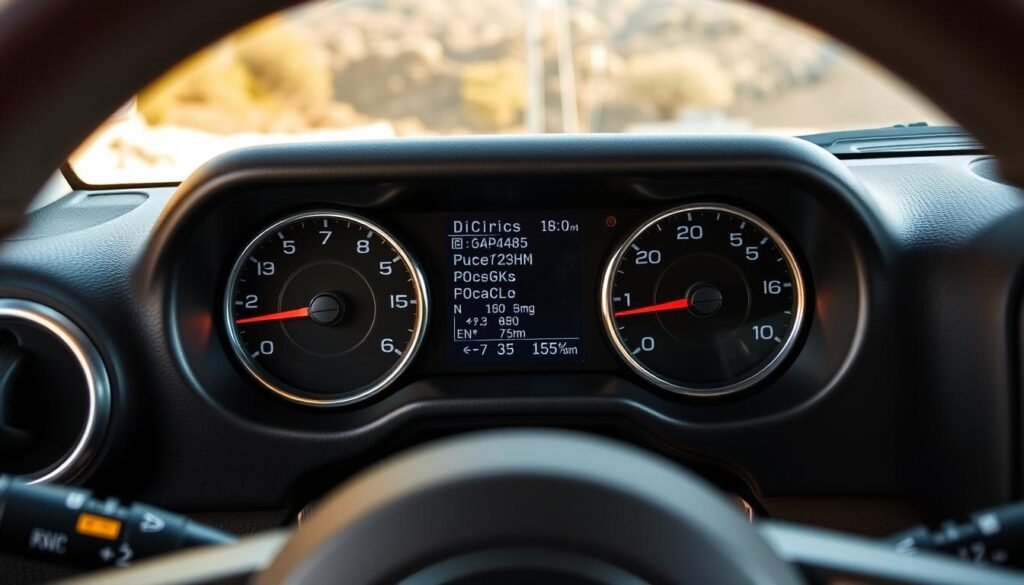
How To Fix Common Check Engine Light Issues
Fixing the check engine light in your Jeep Wrangler can be easy. Learning to solve check engine light issues can save both time and money.
It also makes your drive smoother. You can fix many common problems with some simple steps.
Replacing A Faulty Oxygen Sensor
The oxygen sensor is key for your Jeep to run well and keep emissions low. If it fails, the check engine light usually comes on.
Here’s how to replace the Jeep Wrangler oxygen sensor:
- Use your service manual to find the bad oxygen sensor.
- Before starting, disconnect the negative battery terminal to avoid electrical problems.
- Remove the old sensor from the exhaust system with the right wrench.
- Put in the new oxygen sensor and tighten it as the maker suggests.
- Reconnect the battery, start your Jeep, and check if the light turns off.
Tightening or Replacing A Loose Gas Cap
A faulty gas cap often causes the check engine light to turn on. It’s an easy fix. If you think a loose gas cap is to blame, do this:
- Check the gas cap for damage or signs of wear.
- If loose, tighten it until it clicks.
- Replace it if it’s damaged, using one that fits your Jeep.
- After fixing it, drive a bit to see if the light resets.
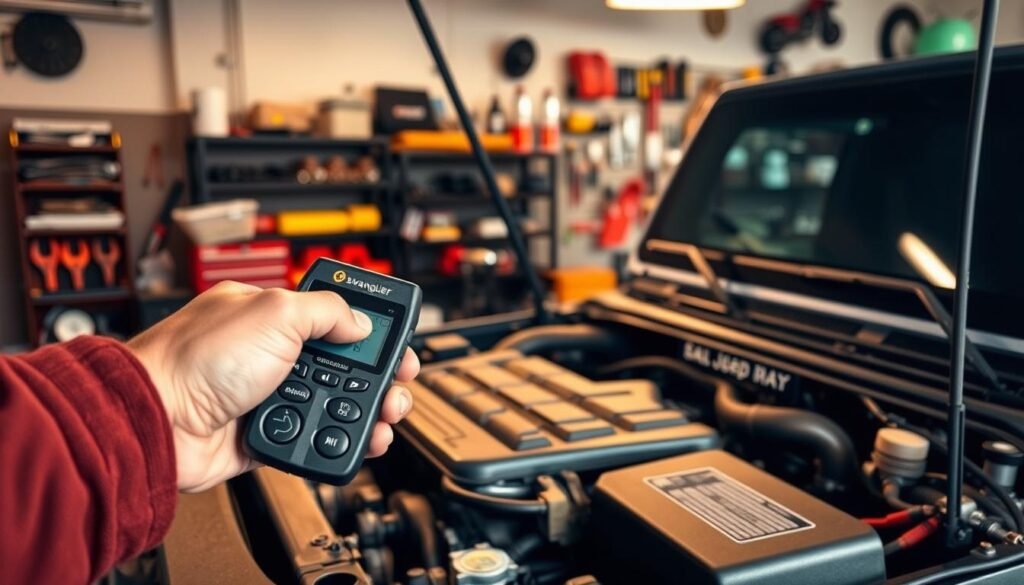
How To Reset Check Engine Light on Jeep Wrangler?
Resetting the check engine light on your Jeep Wrangler is pretty simple. This is crucial to not miss any big problems. You can use an OBD-II scanner or disconnect the battery.
Using an OBD-II Scanner
One fast way to reset the light is with an OBD-II scanner. Just follow these steps:
- Plug the OBD-II scanner into the port under the dashboard on the driver’s side.
- Turn the key to “On” but don’t start the engine.
- Turn on the scanner and choose to read trouble codes.
- Select to clear them after reading. This will reset the Jeep’s OBD-II light.
- Turn the ignition off and remove the scanner.
Disconnecting The Battery
To reset the light, you can also disconnect the battery. Be sure to do it right:
- Make sure everything is off and then disconnect the negative battery cable.
- Wait about 10 to 15 minutes to fully reset.
- Reattach the negative cable tightly.
- Turn your vehicle on and see if the light is off.
Whether you use a scanner or disconnect the battery, always fix the main issue first.
Clearing the codes will help keep your Jeep running well. Enjoy the ride without the check engine light on.
When To Seek Professional Help?
Some issues with your Jeep Wrangler’s check engine light you can fix by yourself. But, if the light flashes, it means there’s a big problem.
Get it checked right away to avoid bigger repair bills. It’s time to visit a mechanic if the check engine light keeps turning on and you’ve already tried to reset it.
If fixing cars isn’t your thing, let a skilled technician handle it. They know what to do and will save you money and time.
Check Engine Light on Jeep Wrangler: Do’s and Don’ts
When your Jeep Wrangler’s check engine light comes on, knowing what to do is important. Checking the gas cap should be your first step.
A loose or damaged cap can cause the light to come on. Also, think about any changes you’ve made to your vehicle recently.
Keeping an eye on your Jeep’s condition helps keep it reliable. It’s also key to get regular diagnostics to catch issues early.
Doing maintenance early saves you money and keeps your Jeep running well. Learn driving tips to make your Jeep Wrangler last longer and perform better.
A major don’t is to overlook the check engine light. If the light is flashing, you need to act fast as it signals a big problem.
Ignoring this can cause big repairs, more costs, and can be unsafe. Knowing what to do about your Jeep Wrangler’s check engine light keeps your mind at ease. It also keeps your vehicle running well.
Conclusion
The check engine light in your Jeep Wrangler is a key sign of the vehicle’s health.
Knowing why this light turns on and how to use diagnostic tools helps you deal with issues confidently.
By keeping up with Jeep Wrangler care tips, you can fix small problems before they turn into big, expensive ones.
Fixing check engine problems doesn’t have to be scary. With the right info, you can tell when you just need to tighten a gas cap or change spark plugs, and when to find expert help.
Regular checks and maintenance boost your vehicle’s dependability and its performance on the road.
Keeping an eye on your Jeep Wrangler’s systems and quickly dealing with the check engine light means a smoother, safer drive.
By doing this, you make sure your Jeep stays in great shape, ready for the adventures ahead.
FAQs
Q: What does it mean when the check engine light is on in my Jeep Wrangler?
A: The check engine light means there’s a problem found by the vehicle’s computer. It could be with the engine or emissions system. Getting it checked quickly is important to avoid damage.
Q: How can I check the diagnostic trouble codes on my Jeep Wrangler?
A: Use an OBD-II scanner to read your Jeep Wrangler’s diagnostic trouble codes. Just plug the scanner into the OBD-II port and follow the screen instructions.
Q: What are some common reasons for the check engine light to come on in a Jeep Wrangler?
A: A loose gas cap, faulty oxygen sensors, and bad spark plugs can turn the light on. Fix these issues quickly to avoid bigger repairs later.
Q: How do I reset the check engine light after fixing an issue?
A: Resetting the check engine light can be done by clearing the trouble codes with an OBD-II scanner. Or, you can unplug the vehicle’s battery for a bit. Always fix the issue before resetting.
Q: When should I seek professional help for my check engine light?
A: If the check engine light is flashing, or if you’re unsure about a big issue, you should see a certified Jeep technician. This helps prevent damage and saves money on repairs.
Q: What are some do’s and don’ts when dealing with the check engine light?
A: Do check the gas cap and any recent vehicle changes. Don’t ignore the light, especially if it’s flashing, indicating a serious issue.
Q: Can I perform diagnostic checks on my Jeep Wrangler myself?
A: You can, using an OBD-II scanner to figure out the trouble codes yourself. But, for complicated issues, it’s best to get help from a pro.

